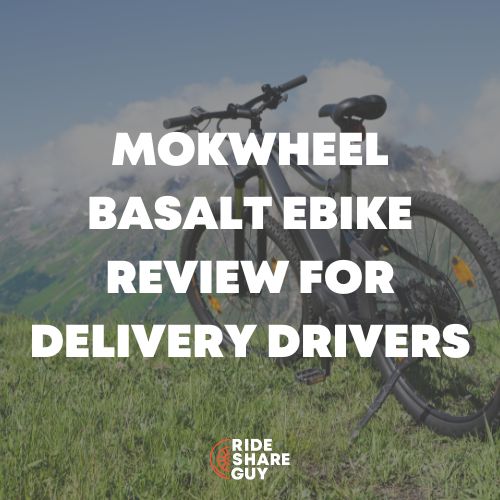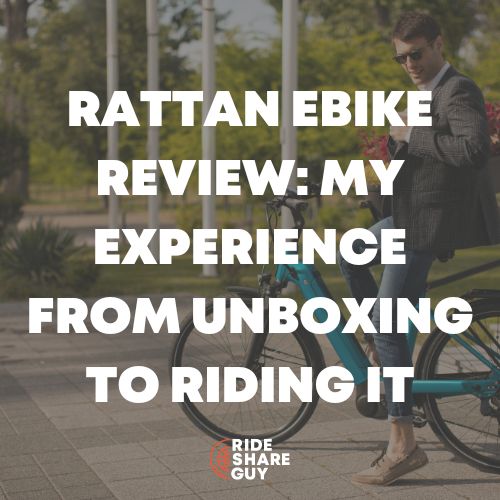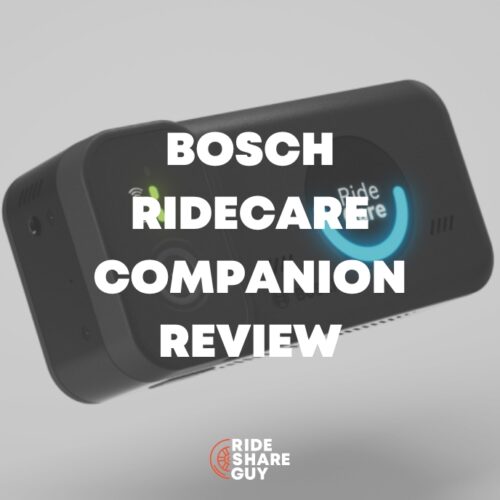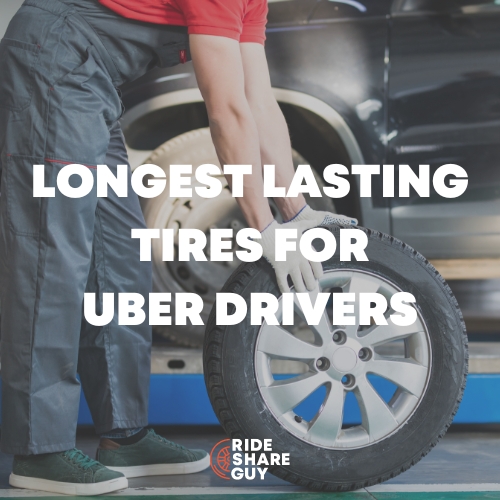Harry here. The battle in Austin has been a huge story over the past month, so Christian and I decided to head to the city that ‘Keeps it Weird’ for four days to see what life is like now that Uber and Lyft are gone. It turns out that there are a slew of rideshare companies looking to take Uber/Lyft’s place, and they’re doing a lot better than we expected.
Today, RSG senior contributor Christian Perea breaks down what it takes for these companies to make a name for themselves and reviews seven of the biggest options in Austin: Wingz, Get Me, Fare, Arcade City, RideAustin, Fasten and InstaRyde.
Austin rideshare is on fire right now. The Big Two are gone and watching from the sidelines with a nervous glance as new companies rampage through a market that they have spent tens of millions of dollars to build. Also, after a month without any real options, passengers and drivers alike are being presented with a bevy of rideshare apps seeking to fill the void. It’s all quite exciting.
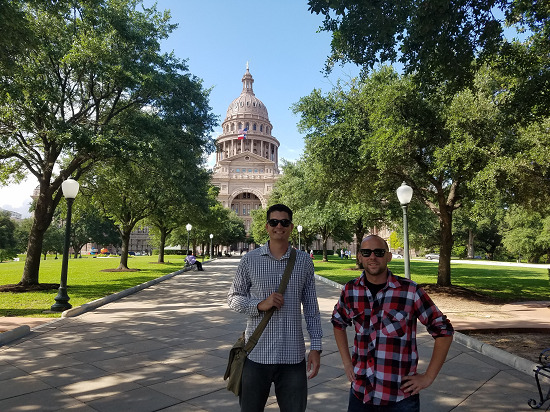
In the wake of Proposition 1 failing, Uber and Lyft decided to exit the City of Austin rather than abide by fingerprinting regulations put in place by the Austin City Council. From Uber and Lyft’s standpoint, fingerprinting creates far too much friction for potential drivers looking to sign-up. According to both companies, their business model cannot survive under such regulations.
However, there are now more than seven rideshare apps available for Austin-ites with varying degrees of service, price, and quality. This gaggle of rideshare startups is racing to deploy a better product and recruit passengers before Uber and Lyft inevitably return. They don’t seem to mind the regulations.
Although drivers have spent close to a month with no real alternatives to Uber and Lyft, they are starting to see something that resembled what they had before Uber and Lyft left.
The New Guys Need 4 Things To Take Austin

Rideshare companies are constantly balancing between these four things: Capital, Technology, Passengers, and Drivers.
Capital: Each company will need enough cash to expand into the Austin market and to make their apps easy to use. All of these companies are less than a year old, and there really isn’t much information on their funding, valuations, or terms from early investors.
This won’t be a big factor right now, but in the mid to long-term, it will be evident and determine whether or not a company will be able to expand beyond Austin. As cash dries up, so do improvements in the app and the ability to recruit drivers and passengers. RideAustin may be an interesting exception since they plan to be a non-profit funded by wealthy locals.
Tech: A lot of people think it’s easy to create an app, but it isn’t. You need lots of engineering manpower in order to ensure a smooth User Interface, while also processing payments, request volume, and all of the highly technical aspects of running a complex piece of software.
This doesn’t mean having the prettiest app but it does mean having the back-end infrastructure that can simultaneously tracking 10,000 moving GPS points at the same time. As drivers, we all know that even the Uber and Lyft apps can crash when it gets busy.
Drivers (Supply): Drivers are in no short supply in Austin right now. Whoever has the most request volume will draw drivers to their platform. This means that local network effects begin to kick-in and the company can expand quickly and handle more passengers. Drivers are pretty upset right now and for good reasons. If a company cannot execute on providing rides, tech, and security of income for them, the drivers will move on to the next company. In other words, companies must earn the trust of drivers. This is hard to do when your company is only a few months old.
Passengers (Demand): All three and no passengers will mean drivers are forced to make their cheddar on other apps. No hard feelings. See Uber vs. Lyft 2015. Right now passengers are confused and waiting for the next app to replace Uber and Lyft in Austin. Passengers are not going to download and test 7 different apps, so whichever one can get out in front of people first and be reliable enough to become their “default” app will stand to succeed in Austin.
This is how Uber won. They focused on making the passenger experience seamless, cheap and mindless. That is why the average person uses it as a verb. The average consumer will adopt whatever app they can get a car with via mashing buttons on a smartphone screen.
Meet Your New Austin Rideshare Companies!
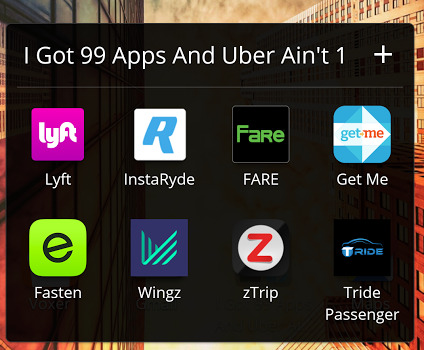
Here are your contestants. They’re competing for your hearts and minds to be The One Company that Austin-ites can learn to love!
We took a ride with almost all of the companies, making sure to talk with drivers about their experience so far with each app. In the process we found out how each company brings something a little bit different to the table for their service. Each have strengths and weaknesses at this point but to be honest, they are adapting so fast it’s hard to point out where they will be in 3 days.
Harry and I experienced no difficulty getting picked up or finding a driver while in Austin. We only paid a variant of “Surge” pricing on a few trips during peak hours. We also met with the CEO’s and other representatives for each company while on our trip to talk about who they are and what their strategy is in order to thrive in Austin. We found that some had stumbled into becoming popular while others moved to Austin with the intention of capturing the market. They are listed below in the order that we used them.
Wingz
Wingz is an app designed for pre-scheduled rides to and from the airport. Drivers earn a minimum of $25 or more from each airport trip. With Wingz, you get fewer requests and higher margins as a driver since the rides tend to be longer and at a higher rate than UberX. Since Wingz’ primary strategy is around airport operations, they provide commercial insurance and operate in compliance with airport regulations.
Wingz is presently recruiting drivers within the Austin area, but they can be a lot pickier with who they hire. They also take customer service very seriously since their service depends on reliability. If you accept a scheduled ride, you better show up for the passenger. Otherwise you must pay a ten dollar cancellation fee to transfer the ride and could risk being deactivated.
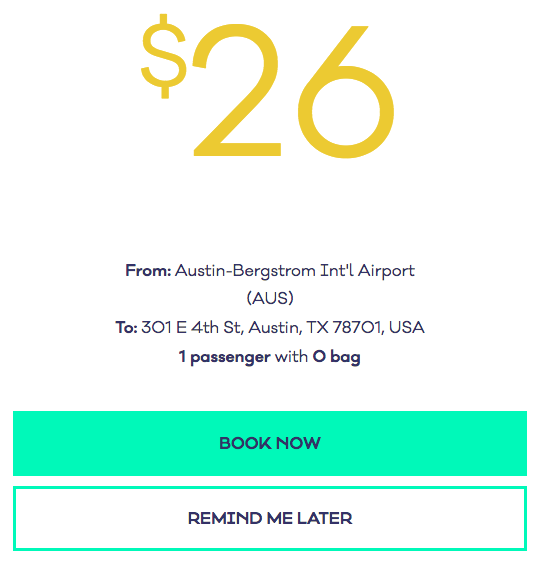
Our ride on Wingz cost $26 and would have cost $13-$18 with Uber. But you can leave a tip. We ended up getting a ride with Anthony who was also our unofficial tour guide and was a big help in setting up a lot of our Austin meetings. Thank you Anthony!
Get $5 off your first Wingz ride here.
FYI – If you’re a driver, you can go here for Wingz Insurance info and to get a quote.
GetMe (Something or Somewhere)
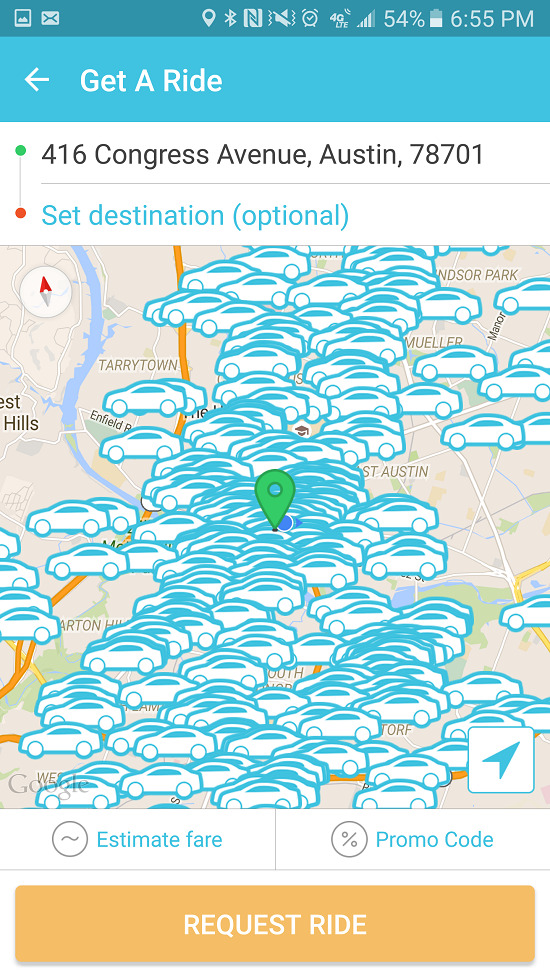
Once we got settled into Austin, we downloaded the first rideshare app that we had heard of. GetMe was in Austin before Uber and Lyft left, so it had a lot of buzz among drivers. The only problem with the app though is that it was designed to be an auxiliary source of income for rideshare drivers to occasionally do extra deliveries and passenger rides. The app is still in its first iteration but the platform has been adopted by many users and drivers rapidly over the past month.
Using the app was a little difficult at first. It displays every single driver available in the area (even the ones who are offline). Literally crowding out the screen with cars. But we were able to get a ride every time we made a request.
On the driver’s side, it uses a more archaic dispatch system that puts each job out to every single driver. This does allow drivers to see the pick-up and destination, but the jobs go quickly.
Drivers complained that they were required to physically swipe down on the screen in order to refresh the job list, which is pretty unsafe while you’re driving around. We took a ride with a driver (thanks Amy!) who demonstrated this to us and we could quickly see how difficult it was. According to GetMe, they are aware of all of this and are working on a solution ASAP.
GetMe actually moved their HQ to Austin prior to the Prop 1 vote and when we spoke with their CXO Jonathan Laramy, he told us that the GetMe app had exploded in downloads when the vote failed. He explained how when GetMe held a sign-up event, they never expected the sheer number of people who were going to show up; that they were quickly overrun with understandably frustrated drivers trying to find a way to survive after the exit of Uber and Lyft. He was so taken aback by how many people had been left without income that he made it a sort of moral focus to get drivers back on the road as soon as possible.
I have heard a lot of TNC leaders say “We care about drivers.” I know when it’s not genuine. Jonathan was genuine.
What Makes GetMe Different?
GetMe pays drivers the most by charging passengers $2.05 per mile. They also allow for drivers to deliver items of any choosing for the same price. Theoretically this makes GetMe a dual rideshare and delivery platform that intends to cast a wide net throughout the sharing economy, but for now they’re mainly doing rideshare rides for obvious reasons. GetMe also does not have dynamic pricing in the same manner as Uber, but they have higher per mile and per minute charges during peak hours. You can tip your driver via the app and rate them 1 – 5 stars.
Challenges
The dispatch nature of the app for rideshare drivers is challenging but this could change in a single update. The price per mile on GetMe is obviously great for drivers but it could also scare off riders used to Uber-like pricing, especially if other companies are charging a lower price. When you combine the high pricing with the strange UI, you can see why it would be easy for passengers to adopt another app for rideshare.
Fare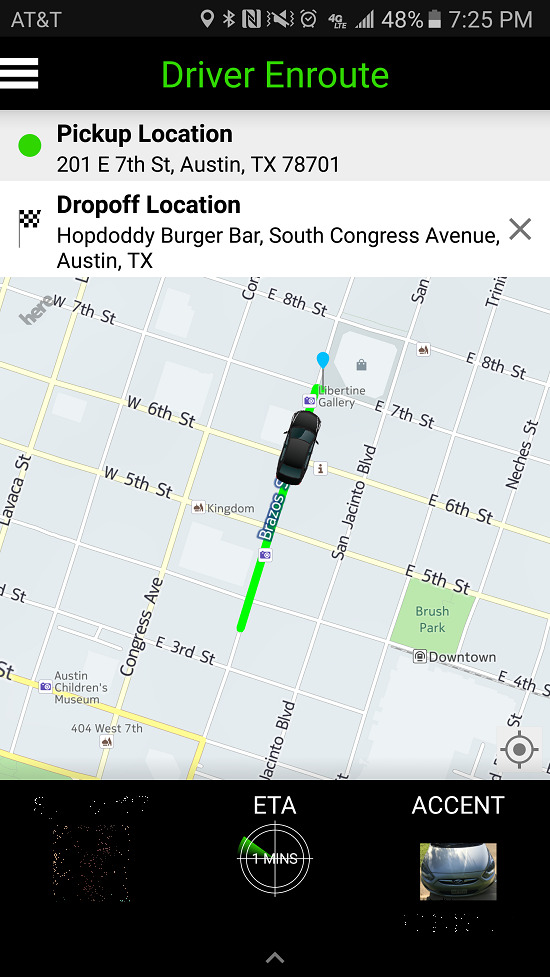
Fare’s UI reminded me of an arcade game. They should have an option for “OG App Skin” when they update it. All of our requests were met relatively quickly.
Fare had a working app and seemed to have a lot of traction among passengers and drivers alike. Of all of the companies in Austin, we saw drivers promoting Fare the most aggressively through signs using their codes. I even saw that a driver purchased an ad on Reddit to promote their Fare code.
What Makes Fare Different?
Fare does not presently have any version of “Surge” pricing. The app is setup to allow for passengers and drivers to “favorite” each other in order to allow choices and to build a clientele. Fare also pays drivers 10% of each future ride when a passenger signs up using their referral code. This seemed a little MLM-like at first but according to the drivers we spoke with, it is a legit referral program.
You can sign up for Fare using our code (Harry13) here.
Fare also allows for pre-scheduled rides. They are betting big on Austin and moving their team and headquarters to Austin with plans to hire locals. There is a tipping option within the app, and the rating is solely based on “Would you ride with Bob again?”
Challenges
Their app and navigation is a bit clunky. There are still a lot of bugs in the app, and it has caused some frustration with drivers and passengers. Michael Leto, the CEO of Fare has been working to get things fixed and replying to driver concerns in their 900 member plus driver Facebook group. He has been admirably transparent and responsive within that group and letting people air their frustration without censorship. Their community of drivers is very strong because of this. It reminds me of early, early Lyft.
So if Fare can improve their tech/app they will be in a strong position. Keep in mind, their app is only 2 months old. So everything can change tomorrow.
Arcade City Facebook Group
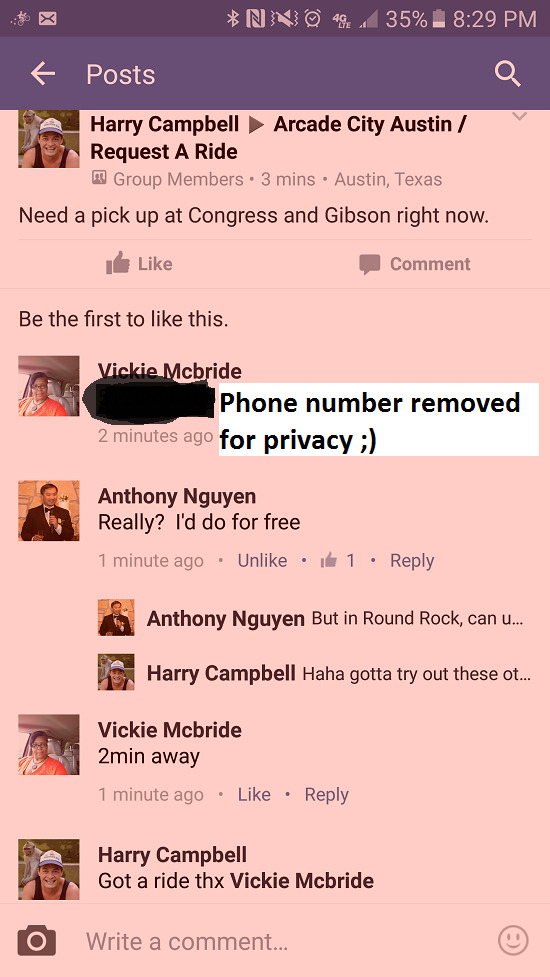
As of today, Arcade City in Austin is just a Facebook group. They do have over 30,000 members though and the group is monitored and administered by Arcade City employees/followers/etc to ensure some semblance of controlled chaos.
The post feed within the group is plastered with ride-seekers and ride-offerers. We saw many people requesting rides through the group and each request would be met with a flurry of drivers responses often with a picture of their Lyft/Uber profile to show their face, car, and rating.
It is important to mention that their rides are not insured. They are not a registered TNC with the City of Austin. So drive and ride at your own risk. We did so for research purposes.
The current system is disorganized and chaotic but it gets the job done. When we requested a ride through their Facebook group, the first person to respond happened to be nearby and picked us up within 2 minutes. Our driver was nice and knew the city well. There is no set pricing, so we gave her $10 in cash (that seemed to be the de-facto minimum fare).
Arcade City presently does not have an app, although they are working on one. They did initially have a Minimum Viable Product that was available for two months but they removed it from the app store in order to work on a second version.
We actually ran into Arcade City’s founder Christopher David and his team by coincidence in a restaurant on our first day of the trip. He was polite enough to ask Harry “So why haven’t you written about us yet a**hole?” and then proceeded to list off all of the other media companies that had written about Arcade City. Guess they’re taking a page out of Uber’s PR playbook 🙂
What Makes Them Different?
I honestly don’t even know where to begin. No insurance. No TNC application. Lots of risk. If they manage to get their app into the world and secure insurance for on-boarded drivers, they have a large list of people they can migrate over to such a platform. Those are two REALLY big things to setup though and time is not on their side.
Challenges
Until they prove otherwise by launching an app and becoming an approved Austin TNC, they are effectively just a Facebook group for bandit cabs. We totally get why drivers are doing this (gotta make money right?) but use this service at your own risk.
RideAustin
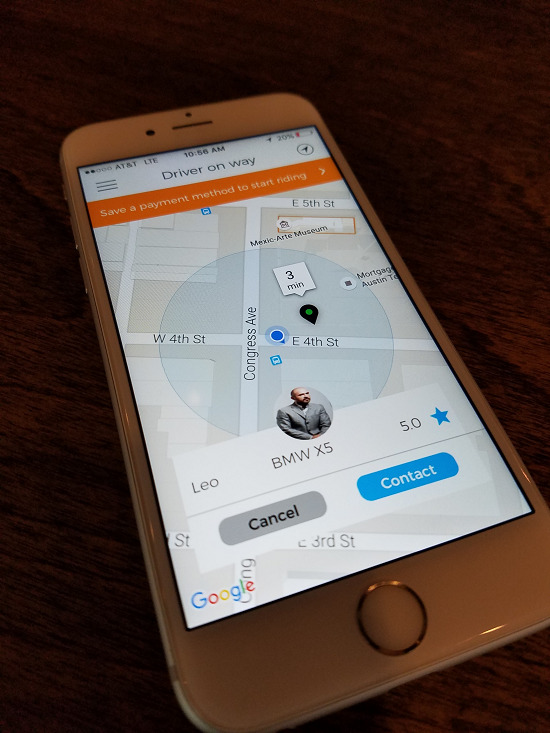
We met with Joe Deshotel at a local coffee shop to talk RideAustin. RideAustin is backed and led by local Trilogy founder Joe Liemandt and Crossover founder Andy Tryba. The goal of Ride Austin is to be a non-profit local solution to rideshare. At the time of meeting with Joe, RideAustin was 3 weeks old and he was already able to display a working beta version of the app.
We have no idea how they got a running beta up so quickly but we tested it and it worked pretty well with just a few minor kinks. We took a test ride with Joe and got a driver name Leo in a white BMW X5 who was great!
What Makes Them Different?
RideAustin is definitely a different take on ridesharing. If Liemandt and Tryba are truly behind it financially and willing to commit, then it should have the resources to be an Austin-friendly local alternative. It could even become a dominant player if cash dries up for its competitors. RideAustin intends to offer options for passengers to round up their fare to donate to a local charity, choose whether or not they will pay surge pricing, and to charge around $1.50/mile for rides similar to UberX or Lyft.
Challenges
The non-profit status depends on wealthy key-players donating money or providing resources to get them up and going. Nobody knows how much it will cost over the next six months to bring them to scale in Austin. And even though they have been quick to build a nice beta app, they are still behind other options that have a working app deployed and are gobbling up passengers and drivers like Pac Man.
Despite all of this, I think RideAustin is a very strong competitor in Austin and given the little time they have been in existence they are doing very well. We just won’t know for sure though until that app can get out in front of people’s faces.
Our RideAustin Experience via Facebook Live
Fasten
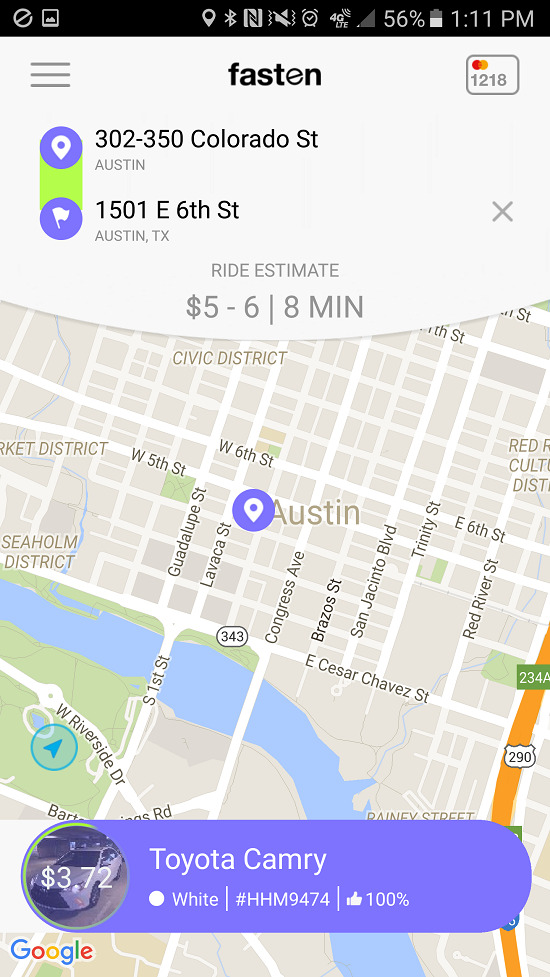
Fasten is straight outta Boston and is run by CEO Kirill Evdakov and COO Vlad Christoff. Fasten has already been operating for close to a year in Boston so they’ve got some experience. Of all the apps we used, Fasten had the most polished and easy to use app from a passenger’s standpoint. We found it very easy to get a ride with them and that the pricing and experience was very similar to UberX. We caught ourselves often defaulting to their app when we needed a ride.
What Makes Fasten Different?
Fasten is different because they only take $.99 cents from each fare plus a $1.50 insurance fee. So the max that they will get paid for a ride given between a rider and driver is $2.49.
Although it does appear that they may also charge drivers the 3% credit card processing fee and a $0.50 fee to cash out your pay.
Fasten offers passengers an option to “boost” their request by paying a multiplier similar t0 surge pricing. Since they do not take a cut from the “boost” prices, they are able to offer slightly lower prices for passengers with slightly higher earnings for drivers. This is because a 2.0 UberX surge will pay about the same to a driver as a 1.5x “Boost” on Fasten, yet the Fasten ride will cost the passenger less.
They do not presently offer a tipping option, and when we were there drivers also complained about lack of a minimum fare and low pricing per mile. Before we left, Fasten actually adjusted their prices from $0.95/mile to $1.15/mile. So it appears that they are keeping their eyes on driver’s concerns.
Challenges
They need a tremendous amount of volume to earn money. Their maximum take is $2.49 per ride (including their insurance fee). This means that convincing investors to choose them in future rounds may be tough. Especially when local competitors are capturing 10-20% of gross ride revenue.
Use the code RSG15 for $15 off your first ride with Fasten.
InstaRyde
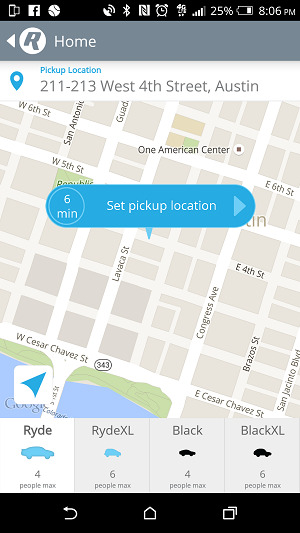
We didn’t get a chance to use InstaRyde, but I wish we had. We did run into one of their representatives though at an Uber Driver Appreciation event we were actually not allowed into (the Uber guy at the door recognized us but didn’t let us in).
The InstaRyde rep chased us down and introduced himself. I appreciated his hustle and downloaded the app on the spot. Turns out it is a working app with a working UI, and they have been operating in Canada for the last few months in two markets.
They are new to the market and in an open beta. So I would encourage you to check them out or apply to drive for them in order to get in early. When we checked the app there were some cars available but not many, I suspect that will change very soon.
Their UI was well polished and everything seemed to work and flow with ease. If you are used to calling an Uber you shouldn’t have too much trouble figuring out how to work the app.
Austin Rideshare Politics: The City, The State, Uber and Lyft
Although many are upset about the exit of Uber and Lyft, the existence of these alternatives will play a big role in deciding whether or not the city feels pressure from locals to adjust their regulations. In the past, Uber and Lyft have been able to effectively apply political pressure because there was no alternative when they left, which left passengers and drivers with plenty of free-time and frustration to protest or write angry emails to their representatives.
The Old Playbook: That Time They Left Broward County.
Right now, if I can give or get a ride with Fasten, Fare, RideAustin, etc – and it is just as safe, cheap, and convenient as Uber or Lyft – then I probably won’t bother even opening their app right? Let alone sending some email or signing a petition. This is the factor that the media is missing: Austin has options where others did not.
Uber and Lyft Still Have Options Though
Uber and Lyft are watching Austin and adopting the strategy of supporting a statewide bill that would legalize and regulate TNC’s. This would override Austin’s regulations on fingerprinting, which would allow them to return without losing face. However there is no telling how long that will take to pass into law. Texas State Legislature is out of session until 2017. Can they hold out that long?
My Take: Life Will Find A Way
Obviously I am excited to see these new companies working on the ground in real-time. After 2 years of typing/reading the words “Uber” and “Lyft” like Bart Simpson on a chalkboard, it was refreshing to see some new players, faces, and a small glimmer of hope for everyone else.
In the absence of rideshare as an earning opportunity, I also witnessed how people really rely on it as a source of income, and the devastating effects when someone who depends on driving for Uber or Lyft loses their job overnight.
After four days in Austin, it was apparent that Uber and Lyft are not required in order for rideshare to exist in a city. Someone will find a way to meet the needs of the market. At the end of our trip, I walked out of terminal 3 at SFO to call a car to get home. It had been a long day of flight delays and humidity and I had sleep on my mind. I reached into my pocket and pulled out my phone to call a car. By accident, I defaulted to the first rideshare app on my mind and it wasn’t Uber and it wasn’t Lyft.
It only took four days for me to get used to riding with someone else, how many others will feel the same?
Readers, what do you think of the new rideshare options in Austin? Do you think Uber and Lyft made a mistake by leaving Austin?
– Christian @ RSG
